Employee Relations: Conflict Resolution at British Airways Report
VerifiedAdded on 2020/07/23
|17
|5511
|28
Report
AI Summary
This report delves into the complexities of employee relations, using British Airways as a case study to illustrate key concepts. It begins by defining employee relations and its significance, followed by an examination of the unitary and pluralistic frames of reference, highlighting their impact on conflict resolution. The report then analyzes how amendments in trade unionism have influenced employee relations, and identifies the main players involved, including management, workers, and government. A significant portion of the report is dedicated to the process of dealing with conflict situations, including an analysis of the steps involved and the features of effective employee relations. The role of negotiation in collective bargaining is explored, along with the impact of strategies in this process. Finally, the report examines the influence of the European Union on industrial democracy, methods for employee participation, and the major impact of the human resource department on employee relations. The conclusion summarizes the findings, providing insights into the development of effective employee relations within an organization like British Airways.
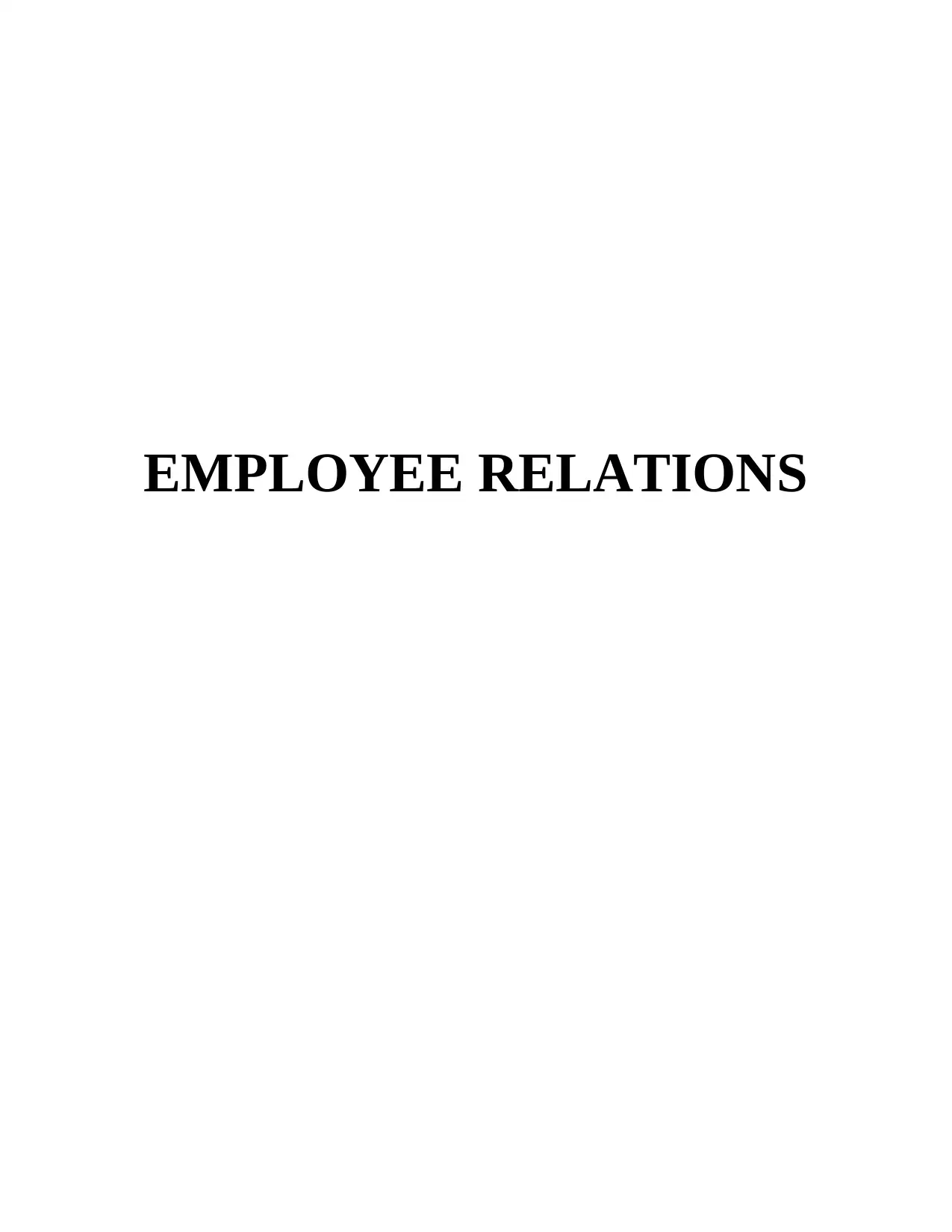
EMPLOYEE RELATIONS
Paraphrase This Document
Need a fresh take? Get an instant paraphrase of this document with our AI Paraphraser
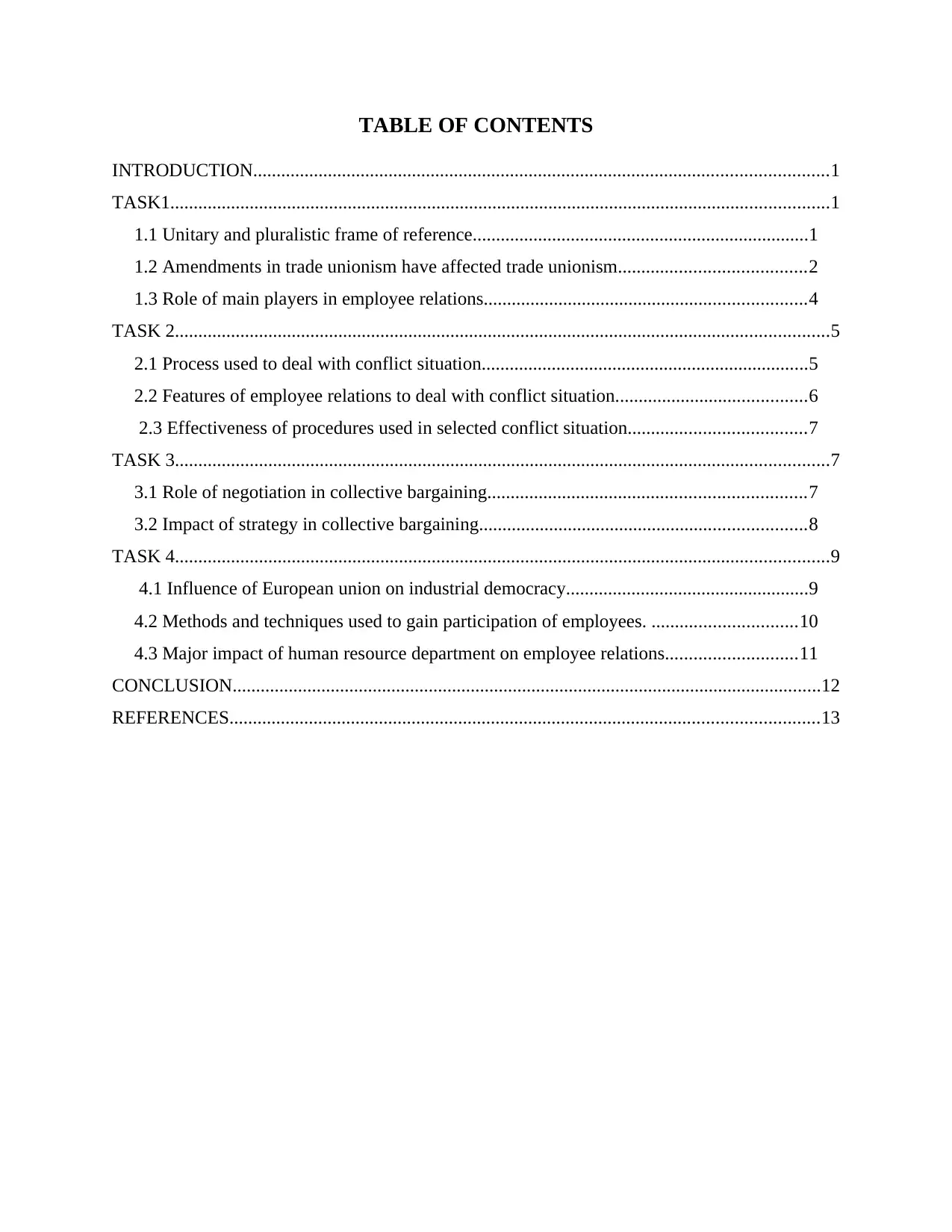
TABLE OF CONTENTS
INTRODUCTION...........................................................................................................................1
TASK1.............................................................................................................................................1
1.1 Unitary and pluralistic frame of reference........................................................................1
1.2 Amendments in trade unionism have affected trade unionism........................................2
1.3 Role of main players in employee relations.....................................................................4
TASK 2............................................................................................................................................5
2.1 Process used to deal with conflict situation......................................................................5
2.2 Features of employee relations to deal with conflict situation.........................................6
2.3 Effectiveness of procedures used in selected conflict situation......................................7
TASK 3............................................................................................................................................7
3.1 Role of negotiation in collective bargaining....................................................................7
3.2 Impact of strategy in collective bargaining......................................................................8
TASK 4............................................................................................................................................9
4.1 Influence of European union on industrial democracy....................................................9
4.2 Methods and techniques used to gain participation of employees. ...............................10
4.3 Major impact of human resource department on employee relations............................11
CONCLUSION..............................................................................................................................12
REFERENCES..............................................................................................................................13
INTRODUCTION...........................................................................................................................1
TASK1.............................................................................................................................................1
1.1 Unitary and pluralistic frame of reference........................................................................1
1.2 Amendments in trade unionism have affected trade unionism........................................2
1.3 Role of main players in employee relations.....................................................................4
TASK 2............................................................................................................................................5
2.1 Process used to deal with conflict situation......................................................................5
2.2 Features of employee relations to deal with conflict situation.........................................6
2.3 Effectiveness of procedures used in selected conflict situation......................................7
TASK 3............................................................................................................................................7
3.1 Role of negotiation in collective bargaining....................................................................7
3.2 Impact of strategy in collective bargaining......................................................................8
TASK 4............................................................................................................................................9
4.1 Influence of European union on industrial democracy....................................................9
4.2 Methods and techniques used to gain participation of employees. ...............................10
4.3 Major impact of human resource department on employee relations............................11
CONCLUSION..............................................................................................................................12
REFERENCES..............................................................................................................................13
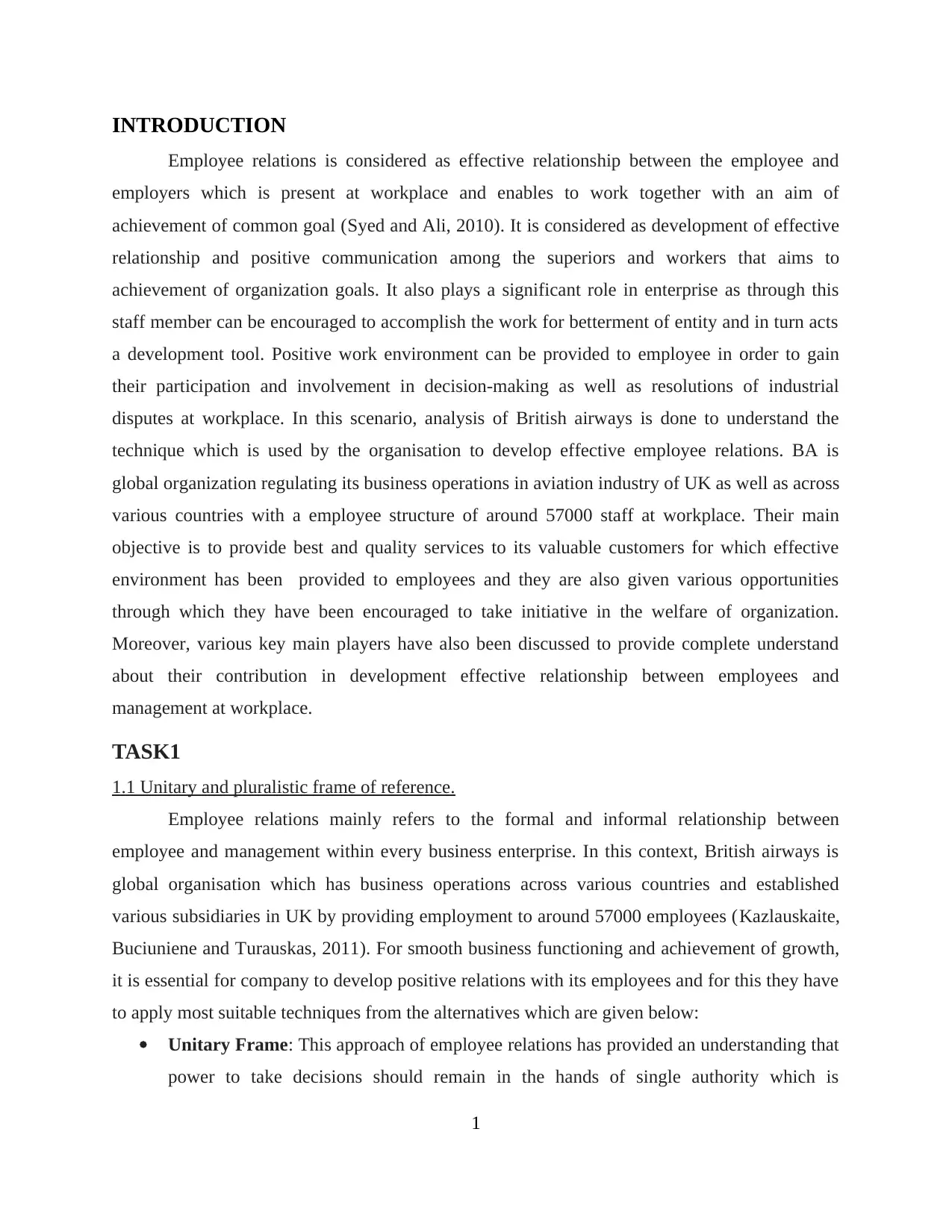
INTRODUCTION
Employee relations is considered as effective relationship between the employee and
employers which is present at workplace and enables to work together with an aim of
achievement of common goal (Syed and Ali, 2010). It is considered as development of effective
relationship and positive communication among the superiors and workers that aims to
achievement of organization goals. It also plays a significant role in enterprise as through this
staff member can be encouraged to accomplish the work for betterment of entity and in turn acts
a development tool. Positive work environment can be provided to employee in order to gain
their participation and involvement in decision-making as well as resolutions of industrial
disputes at workplace. In this scenario, analysis of British airways is done to understand the
technique which is used by the organisation to develop effective employee relations. BA is
global organization regulating its business operations in aviation industry of UK as well as across
various countries with a employee structure of around 57000 staff at workplace. Their main
objective is to provide best and quality services to its valuable customers for which effective
environment has been provided to employees and they are also given various opportunities
through which they have been encouraged to take initiative in the welfare of organization.
Moreover, various key main players have also been discussed to provide complete understand
about their contribution in development effective relationship between employees and
management at workplace.
TASK1
1.1 Unitary and pluralistic frame of reference.
Employee relations mainly refers to the formal and informal relationship between
employee and management within every business enterprise. In this context, British airways is
global organisation which has business operations across various countries and established
various subsidiaries in UK by providing employment to around 57000 employees (Kazlauskaite,
Buciuniene and Turauskas, 2011). For smooth business functioning and achievement of growth,
it is essential for company to develop positive relations with its employees and for this they have
to apply most suitable techniques from the alternatives which are given below:
Unitary Frame: This approach of employee relations has provided an understanding that
power to take decisions should remain in the hands of single authority which is
1
Employee relations is considered as effective relationship between the employee and
employers which is present at workplace and enables to work together with an aim of
achievement of common goal (Syed and Ali, 2010). It is considered as development of effective
relationship and positive communication among the superiors and workers that aims to
achievement of organization goals. It also plays a significant role in enterprise as through this
staff member can be encouraged to accomplish the work for betterment of entity and in turn acts
a development tool. Positive work environment can be provided to employee in order to gain
their participation and involvement in decision-making as well as resolutions of industrial
disputes at workplace. In this scenario, analysis of British airways is done to understand the
technique which is used by the organisation to develop effective employee relations. BA is
global organization regulating its business operations in aviation industry of UK as well as across
various countries with a employee structure of around 57000 staff at workplace. Their main
objective is to provide best and quality services to its valuable customers for which effective
environment has been provided to employees and they are also given various opportunities
through which they have been encouraged to take initiative in the welfare of organization.
Moreover, various key main players have also been discussed to provide complete understand
about their contribution in development effective relationship between employees and
management at workplace.
TASK1
1.1 Unitary and pluralistic frame of reference.
Employee relations mainly refers to the formal and informal relationship between
employee and management within every business enterprise. In this context, British airways is
global organisation which has business operations across various countries and established
various subsidiaries in UK by providing employment to around 57000 employees (Kazlauskaite,
Buciuniene and Turauskas, 2011). For smooth business functioning and achievement of growth,
it is essential for company to develop positive relations with its employees and for this they have
to apply most suitable techniques from the alternatives which are given below:
Unitary Frame: This approach of employee relations has provided an understanding that
power to take decisions should remain in the hands of single authority which is
1
⊘ This is a preview!⊘
Do you want full access?
Subscribe today to unlock all pages.

Trusted by 1+ million students worldwide
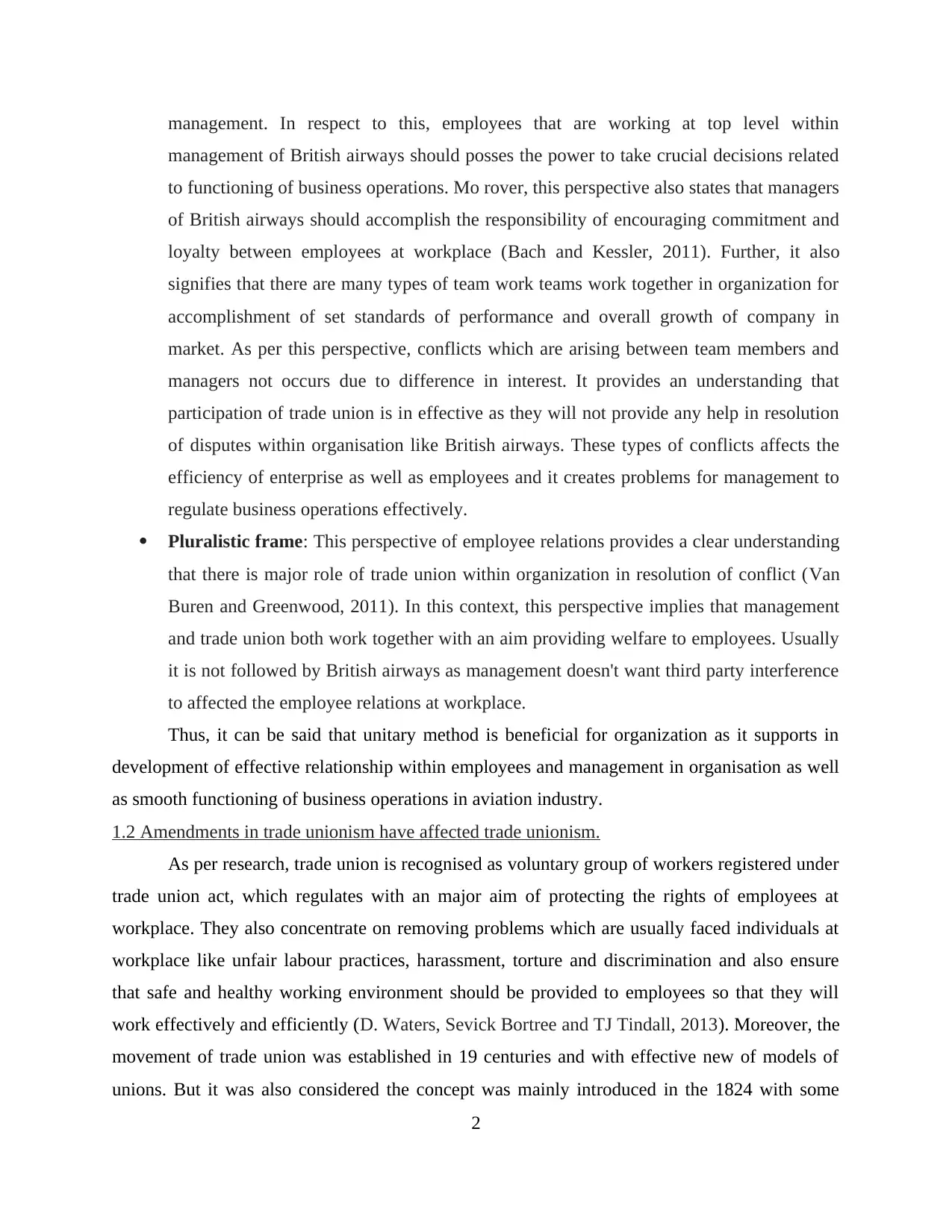
management. In respect to this, employees that are working at top level within
management of British airways should posses the power to take crucial decisions related
to functioning of business operations. Mo rover, this perspective also states that managers
of British airways should accomplish the responsibility of encouraging commitment and
loyalty between employees at workplace (Bach and Kessler, 2011). Further, it also
signifies that there are many types of team work teams work together in organization for
accomplishment of set standards of performance and overall growth of company in
market. As per this perspective, conflicts which are arising between team members and
managers not occurs due to difference in interest. It provides an understanding that
participation of trade union is in effective as they will not provide any help in resolution
of disputes within organisation like British airways. These types of conflicts affects the
efficiency of enterprise as well as employees and it creates problems for management to
regulate business operations effectively.
Pluralistic frame: This perspective of employee relations provides a clear understanding
that there is major role of trade union within organization in resolution of conflict (Van
Buren and Greenwood, 2011). In this context, this perspective implies that management
and trade union both work together with an aim providing welfare to employees. Usually
it is not followed by British airways as management doesn't want third party interference
to affected the employee relations at workplace.
Thus, it can be said that unitary method is beneficial for organization as it supports in
development of effective relationship within employees and management in organisation as well
as smooth functioning of business operations in aviation industry.
1.2 Amendments in trade unionism have affected trade unionism.
As per research, trade union is recognised as voluntary group of workers registered under
trade union act, which regulates with an major aim of protecting the rights of employees at
workplace. They also concentrate on removing problems which are usually faced individuals at
workplace like unfair labour practices, harassment, torture and discrimination and also ensure
that safe and healthy working environment should be provided to employees so that they will
work effectively and efficiently (D. Waters, Sevick Bortree and TJ Tindall, 2013). Moreover, the
movement of trade union was established in 19 centuries and with effective new of models of
unions. But it was also considered the concept was mainly introduced in the 1824 with some
2
management of British airways should posses the power to take crucial decisions related
to functioning of business operations. Mo rover, this perspective also states that managers
of British airways should accomplish the responsibility of encouraging commitment and
loyalty between employees at workplace (Bach and Kessler, 2011). Further, it also
signifies that there are many types of team work teams work together in organization for
accomplishment of set standards of performance and overall growth of company in
market. As per this perspective, conflicts which are arising between team members and
managers not occurs due to difference in interest. It provides an understanding that
participation of trade union is in effective as they will not provide any help in resolution
of disputes within organisation like British airways. These types of conflicts affects the
efficiency of enterprise as well as employees and it creates problems for management to
regulate business operations effectively.
Pluralistic frame: This perspective of employee relations provides a clear understanding
that there is major role of trade union within organization in resolution of conflict (Van
Buren and Greenwood, 2011). In this context, this perspective implies that management
and trade union both work together with an aim providing welfare to employees. Usually
it is not followed by British airways as management doesn't want third party interference
to affected the employee relations at workplace.
Thus, it can be said that unitary method is beneficial for organization as it supports in
development of effective relationship within employees and management in organisation as well
as smooth functioning of business operations in aviation industry.
1.2 Amendments in trade unionism have affected trade unionism.
As per research, trade union is recognised as voluntary group of workers registered under
trade union act, which regulates with an major aim of protecting the rights of employees at
workplace. They also concentrate on removing problems which are usually faced individuals at
workplace like unfair labour practices, harassment, torture and discrimination and also ensure
that safe and healthy working environment should be provided to employees so that they will
work effectively and efficiently (D. Waters, Sevick Bortree and TJ Tindall, 2013). Moreover, the
movement of trade union was established in 19 centuries and with effective new of models of
unions. But it was also considered the concept was mainly introduced in the 1824 with some
2
Paraphrase This Document
Need a fresh take? Get an instant paraphrase of this document with our AI Paraphraser
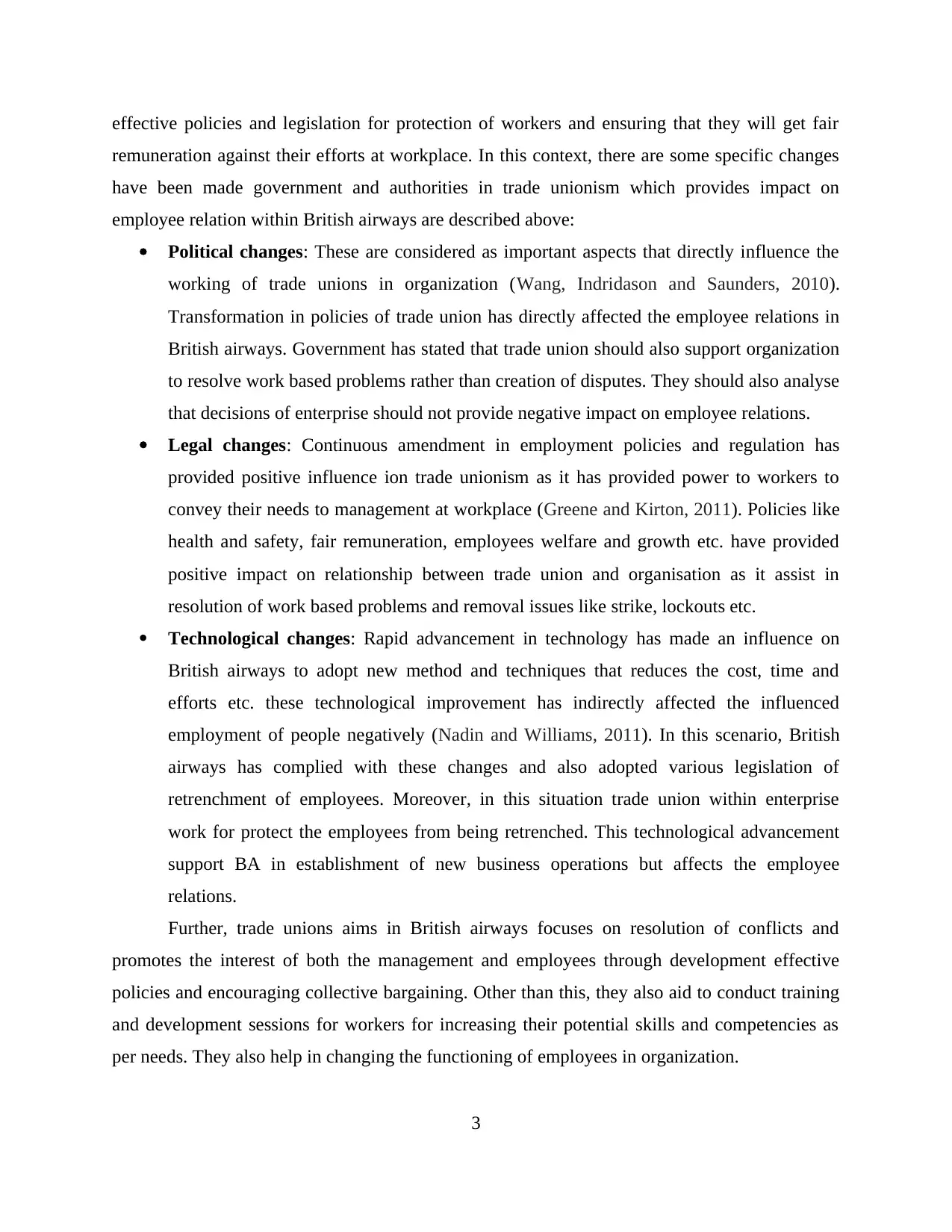
effective policies and legislation for protection of workers and ensuring that they will get fair
remuneration against their efforts at workplace. In this context, there are some specific changes
have been made government and authorities in trade unionism which provides impact on
employee relation within British airways are described above:
Political changes: These are considered as important aspects that directly influence the
working of trade unions in organization (Wang, Indridason and Saunders, 2010).
Transformation in policies of trade union has directly affected the employee relations in
British airways. Government has stated that trade union should also support organization
to resolve work based problems rather than creation of disputes. They should also analyse
that decisions of enterprise should not provide negative impact on employee relations.
Legal changes: Continuous amendment in employment policies and regulation has
provided positive influence ion trade unionism as it has provided power to workers to
convey their needs to management at workplace (Greene and Kirton, 2011). Policies like
health and safety, fair remuneration, employees welfare and growth etc. have provided
positive impact on relationship between trade union and organisation as it assist in
resolution of work based problems and removal issues like strike, lockouts etc.
Technological changes: Rapid advancement in technology has made an influence on
British airways to adopt new method and techniques that reduces the cost, time and
efforts etc. these technological improvement has indirectly affected the influenced
employment of people negatively (Nadin and Williams, 2011). In this scenario, British
airways has complied with these changes and also adopted various legislation of
retrenchment of employees. Moreover, in this situation trade union within enterprise
work for protect the employees from being retrenched. This technological advancement
support BA in establishment of new business operations but affects the employee
relations.
Further, trade unions aims in British airways focuses on resolution of conflicts and
promotes the interest of both the management and employees through development effective
policies and encouraging collective bargaining. Other than this, they also aid to conduct training
and development sessions for workers for increasing their potential skills and competencies as
per needs. They also help in changing the functioning of employees in organization.
3
remuneration against their efforts at workplace. In this context, there are some specific changes
have been made government and authorities in trade unionism which provides impact on
employee relation within British airways are described above:
Political changes: These are considered as important aspects that directly influence the
working of trade unions in organization (Wang, Indridason and Saunders, 2010).
Transformation in policies of trade union has directly affected the employee relations in
British airways. Government has stated that trade union should also support organization
to resolve work based problems rather than creation of disputes. They should also analyse
that decisions of enterprise should not provide negative impact on employee relations.
Legal changes: Continuous amendment in employment policies and regulation has
provided positive influence ion trade unionism as it has provided power to workers to
convey their needs to management at workplace (Greene and Kirton, 2011). Policies like
health and safety, fair remuneration, employees welfare and growth etc. have provided
positive impact on relationship between trade union and organisation as it assist in
resolution of work based problems and removal issues like strike, lockouts etc.
Technological changes: Rapid advancement in technology has made an influence on
British airways to adopt new method and techniques that reduces the cost, time and
efforts etc. these technological improvement has indirectly affected the influenced
employment of people negatively (Nadin and Williams, 2011). In this scenario, British
airways has complied with these changes and also adopted various legislation of
retrenchment of employees. Moreover, in this situation trade union within enterprise
work for protect the employees from being retrenched. This technological advancement
support BA in establishment of new business operations but affects the employee
relations.
Further, trade unions aims in British airways focuses on resolution of conflicts and
promotes the interest of both the management and employees through development effective
policies and encouraging collective bargaining. Other than this, they also aid to conduct training
and development sessions for workers for increasing their potential skills and competencies as
per needs. They also help in changing the functioning of employees in organization.
3
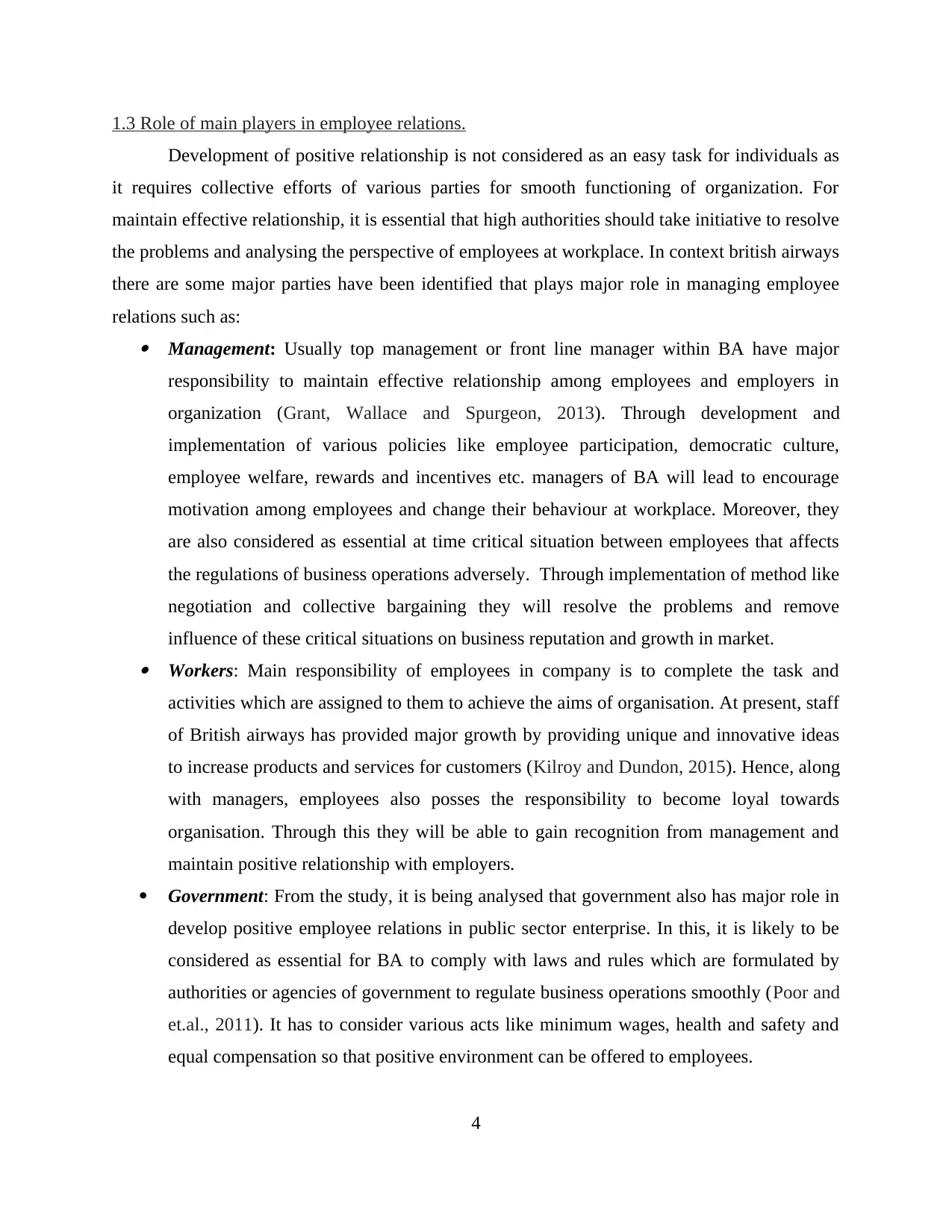
1.3 Role of main players in employee relations.
Development of positive relationship is not considered as an easy task for individuals as
it requires collective efforts of various parties for smooth functioning of organization. For
maintain effective relationship, it is essential that high authorities should take initiative to resolve
the problems and analysing the perspective of employees at workplace. In context british airways
there are some major parties have been identified that plays major role in managing employee
relations such as: Management: Usually top management or front line manager within BA have major
responsibility to maintain effective relationship among employees and employers in
organization (Grant, Wallace and Spurgeon, 2013). Through development and
implementation of various policies like employee participation, democratic culture,
employee welfare, rewards and incentives etc. managers of BA will lead to encourage
motivation among employees and change their behaviour at workplace. Moreover, they
are also considered as essential at time critical situation between employees that affects
the regulations of business operations adversely. Through implementation of method like
negotiation and collective bargaining they will resolve the problems and remove
influence of these critical situations on business reputation and growth in market. Workers: Main responsibility of employees in company is to complete the task and
activities which are assigned to them to achieve the aims of organisation. At present, staff
of British airways has provided major growth by providing unique and innovative ideas
to increase products and services for customers (Kilroy and Dundon, 2015). Hence, along
with managers, employees also posses the responsibility to become loyal towards
organisation. Through this they will be able to gain recognition from management and
maintain positive relationship with employers.
Government: From the study, it is being analysed that government also has major role in
develop positive employee relations in public sector enterprise. In this, it is likely to be
considered as essential for BA to comply with laws and rules which are formulated by
authorities or agencies of government to regulate business operations smoothly (Poor and
et.al., 2011). It has to consider various acts like minimum wages, health and safety and
equal compensation so that positive environment can be offered to employees.
4
Development of positive relationship is not considered as an easy task for individuals as
it requires collective efforts of various parties for smooth functioning of organization. For
maintain effective relationship, it is essential that high authorities should take initiative to resolve
the problems and analysing the perspective of employees at workplace. In context british airways
there are some major parties have been identified that plays major role in managing employee
relations such as: Management: Usually top management or front line manager within BA have major
responsibility to maintain effective relationship among employees and employers in
organization (Grant, Wallace and Spurgeon, 2013). Through development and
implementation of various policies like employee participation, democratic culture,
employee welfare, rewards and incentives etc. managers of BA will lead to encourage
motivation among employees and change their behaviour at workplace. Moreover, they
are also considered as essential at time critical situation between employees that affects
the regulations of business operations adversely. Through implementation of method like
negotiation and collective bargaining they will resolve the problems and remove
influence of these critical situations on business reputation and growth in market. Workers: Main responsibility of employees in company is to complete the task and
activities which are assigned to them to achieve the aims of organisation. At present, staff
of British airways has provided major growth by providing unique and innovative ideas
to increase products and services for customers (Kilroy and Dundon, 2015). Hence, along
with managers, employees also posses the responsibility to become loyal towards
organisation. Through this they will be able to gain recognition from management and
maintain positive relationship with employers.
Government: From the study, it is being analysed that government also has major role in
develop positive employee relations in public sector enterprise. In this, it is likely to be
considered as essential for BA to comply with laws and rules which are formulated by
authorities or agencies of government to regulate business operations smoothly (Poor and
et.al., 2011). It has to consider various acts like minimum wages, health and safety and
equal compensation so that positive environment can be offered to employees.
4
⊘ This is a preview!⊘
Do you want full access?
Subscribe today to unlock all pages.

Trusted by 1+ million students worldwide
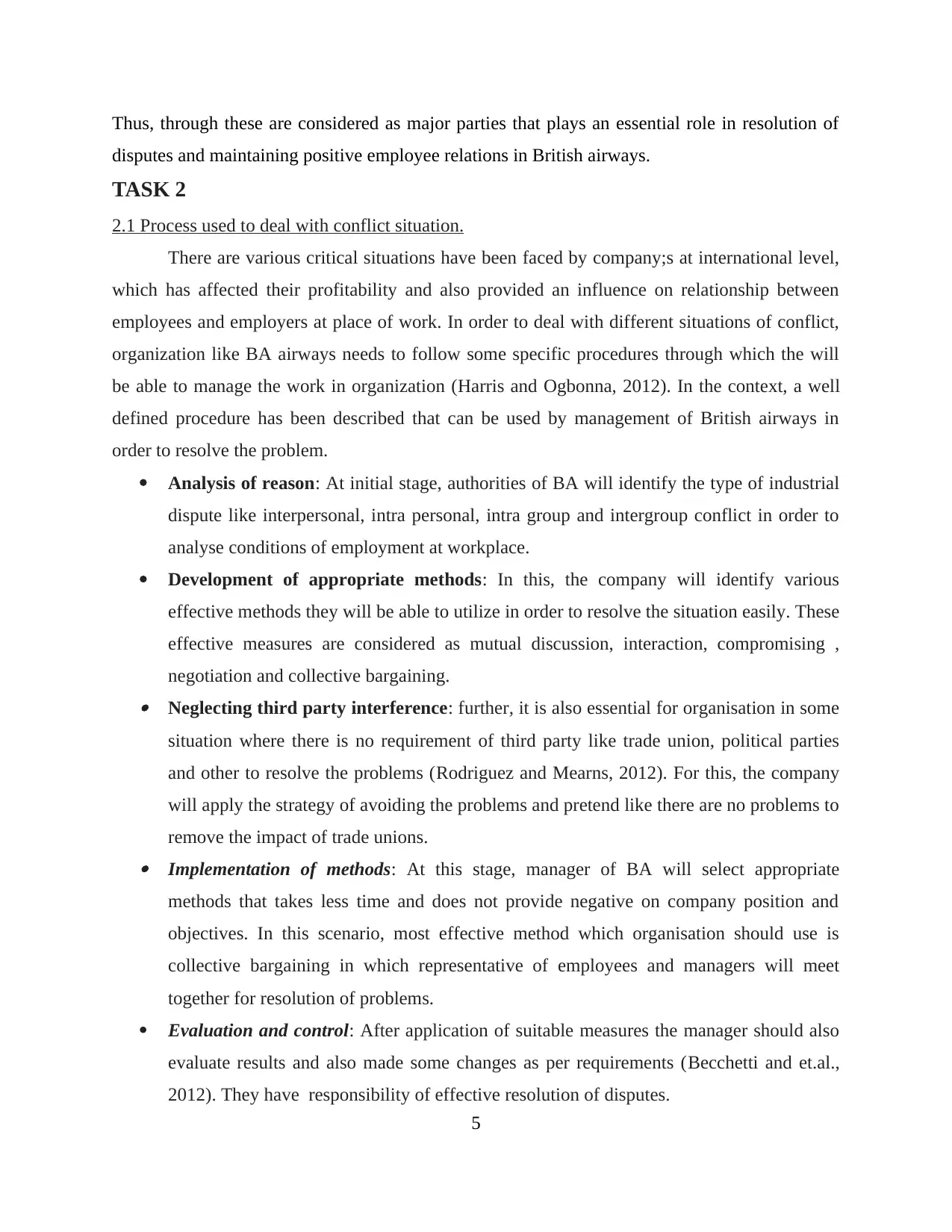
Thus, through these are considered as major parties that plays an essential role in resolution of
disputes and maintaining positive employee relations in British airways.
TASK 2
2.1 Process used to deal with conflict situation.
There are various critical situations have been faced by company;s at international level,
which has affected their profitability and also provided an influence on relationship between
employees and employers at place of work. In order to deal with different situations of conflict,
organization like BA airways needs to follow some specific procedures through which the will
be able to manage the work in organization (Harris and Ogbonna, 2012). In the context, a well
defined procedure has been described that can be used by management of British airways in
order to resolve the problem.
Analysis of reason: At initial stage, authorities of BA will identify the type of industrial
dispute like interpersonal, intra personal, intra group and intergroup conflict in order to
analyse conditions of employment at workplace.
Development of appropriate methods: In this, the company will identify various
effective methods they will be able to utilize in order to resolve the situation easily. These
effective measures are considered as mutual discussion, interaction, compromising ,
negotiation and collective bargaining. Neglecting third party interference: further, it is also essential for organisation in some
situation where there is no requirement of third party like trade union, political parties
and other to resolve the problems (Rodriguez and Mearns, 2012). For this, the company
will apply the strategy of avoiding the problems and pretend like there are no problems to
remove the impact of trade unions. Implementation of methods: At this stage, manager of BA will select appropriate
methods that takes less time and does not provide negative on company position and
objectives. In this scenario, most effective method which organisation should use is
collective bargaining in which representative of employees and managers will meet
together for resolution of problems.
Evaluation and control: After application of suitable measures the manager should also
evaluate results and also made some changes as per requirements (Becchetti and et.al.,
2012). They have responsibility of effective resolution of disputes.
5
disputes and maintaining positive employee relations in British airways.
TASK 2
2.1 Process used to deal with conflict situation.
There are various critical situations have been faced by company;s at international level,
which has affected their profitability and also provided an influence on relationship between
employees and employers at place of work. In order to deal with different situations of conflict,
organization like BA airways needs to follow some specific procedures through which the will
be able to manage the work in organization (Harris and Ogbonna, 2012). In the context, a well
defined procedure has been described that can be used by management of British airways in
order to resolve the problem.
Analysis of reason: At initial stage, authorities of BA will identify the type of industrial
dispute like interpersonal, intra personal, intra group and intergroup conflict in order to
analyse conditions of employment at workplace.
Development of appropriate methods: In this, the company will identify various
effective methods they will be able to utilize in order to resolve the situation easily. These
effective measures are considered as mutual discussion, interaction, compromising ,
negotiation and collective bargaining. Neglecting third party interference: further, it is also essential for organisation in some
situation where there is no requirement of third party like trade union, political parties
and other to resolve the problems (Rodriguez and Mearns, 2012). For this, the company
will apply the strategy of avoiding the problems and pretend like there are no problems to
remove the impact of trade unions. Implementation of methods: At this stage, manager of BA will select appropriate
methods that takes less time and does not provide negative on company position and
objectives. In this scenario, most effective method which organisation should use is
collective bargaining in which representative of employees and managers will meet
together for resolution of problems.
Evaluation and control: After application of suitable measures the manager should also
evaluate results and also made some changes as per requirements (Becchetti and et.al.,
2012). They have responsibility of effective resolution of disputes.
5
Paraphrase This Document
Need a fresh take? Get an instant paraphrase of this document with our AI Paraphraser
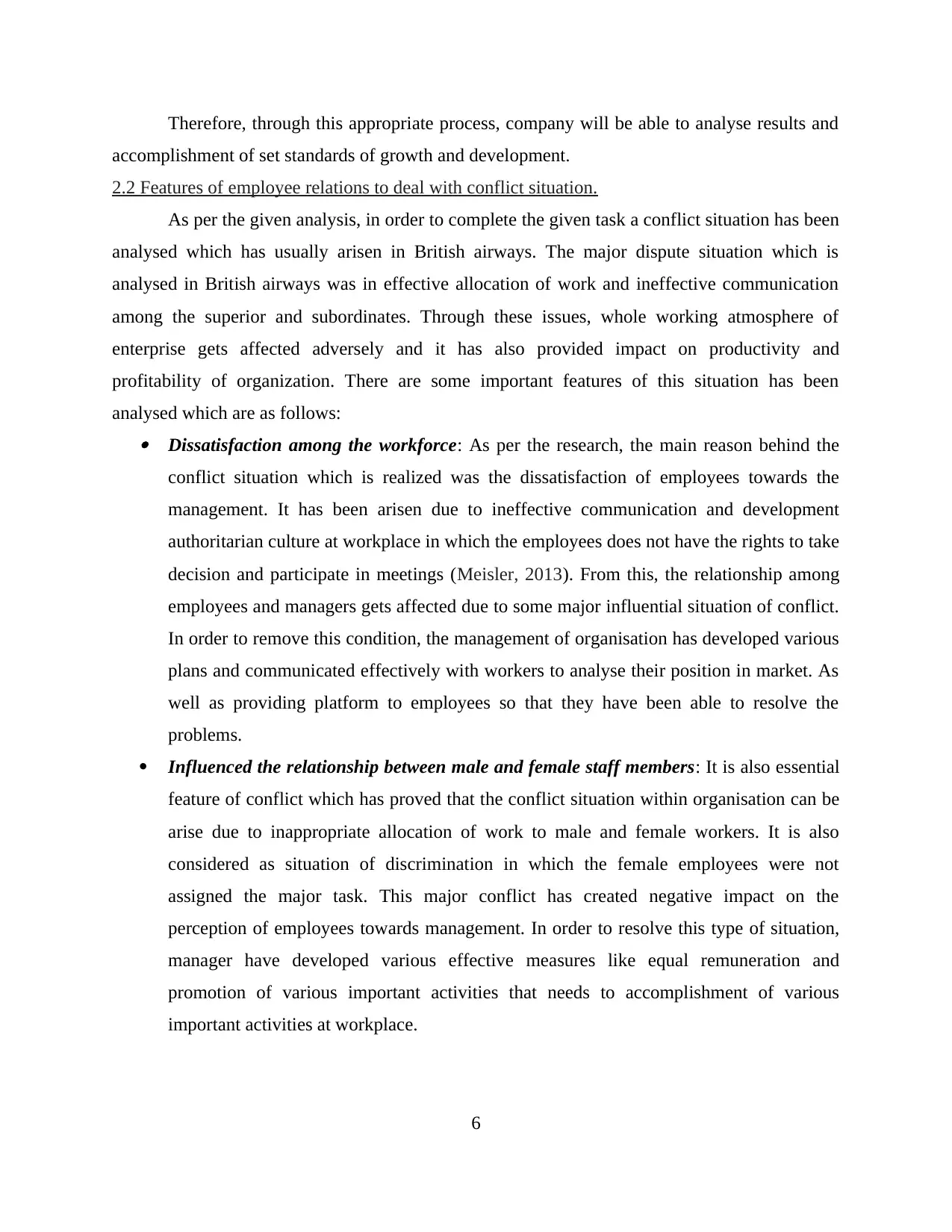
Therefore, through this appropriate process, company will be able to analyse results and
accomplishment of set standards of growth and development.
2.2 Features of employee relations to deal with conflict situation.
As per the given analysis, in order to complete the given task a conflict situation has been
analysed which has usually arisen in British airways. The major dispute situation which is
analysed in British airways was in effective allocation of work and ineffective communication
among the superior and subordinates. Through these issues, whole working atmosphere of
enterprise gets affected adversely and it has also provided impact on productivity and
profitability of organization. There are some important features of this situation has been
analysed which are as follows: Dissatisfaction among the workforce: As per the research, the main reason behind the
conflict situation which is realized was the dissatisfaction of employees towards the
management. It has been arisen due to ineffective communication and development
authoritarian culture at workplace in which the employees does not have the rights to take
decision and participate in meetings (Meisler, 2013). From this, the relationship among
employees and managers gets affected due to some major influential situation of conflict.
In order to remove this condition, the management of organisation has developed various
plans and communicated effectively with workers to analyse their position in market. As
well as providing platform to employees so that they have been able to resolve the
problems.
Influenced the relationship between male and female staff members: It is also essential
feature of conflict which has proved that the conflict situation within organisation can be
arise due to inappropriate allocation of work to male and female workers. It is also
considered as situation of discrimination in which the female employees were not
assigned the major task. This major conflict has created negative impact on the
perception of employees towards management. In order to resolve this type of situation,
manager have developed various effective measures like equal remuneration and
promotion of various important activities that needs to accomplishment of various
important activities at workplace.
6
accomplishment of set standards of growth and development.
2.2 Features of employee relations to deal with conflict situation.
As per the given analysis, in order to complete the given task a conflict situation has been
analysed which has usually arisen in British airways. The major dispute situation which is
analysed in British airways was in effective allocation of work and ineffective communication
among the superior and subordinates. Through these issues, whole working atmosphere of
enterprise gets affected adversely and it has also provided impact on productivity and
profitability of organization. There are some important features of this situation has been
analysed which are as follows: Dissatisfaction among the workforce: As per the research, the main reason behind the
conflict situation which is realized was the dissatisfaction of employees towards the
management. It has been arisen due to ineffective communication and development
authoritarian culture at workplace in which the employees does not have the rights to take
decision and participate in meetings (Meisler, 2013). From this, the relationship among
employees and managers gets affected due to some major influential situation of conflict.
In order to remove this condition, the management of organisation has developed various
plans and communicated effectively with workers to analyse their position in market. As
well as providing platform to employees so that they have been able to resolve the
problems.
Influenced the relationship between male and female staff members: It is also essential
feature of conflict which has proved that the conflict situation within organisation can be
arise due to inappropriate allocation of work to male and female workers. It is also
considered as situation of discrimination in which the female employees were not
assigned the major task. This major conflict has created negative impact on the
perception of employees towards management. In order to resolve this type of situation,
manager have developed various effective measures like equal remuneration and
promotion of various important activities that needs to accomplishment of various
important activities at workplace.
6
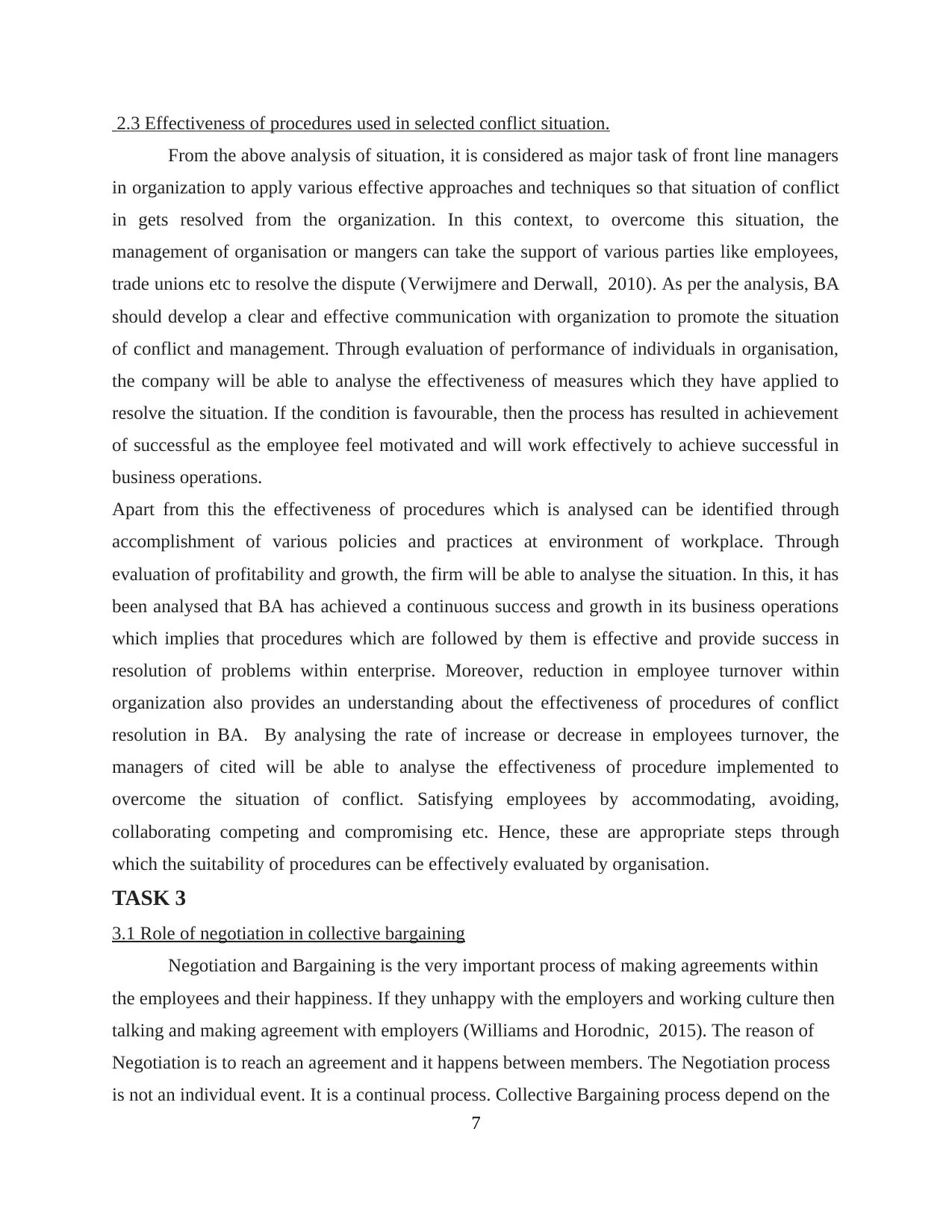
2.3 Effectiveness of procedures used in selected conflict situation.
From the above analysis of situation, it is considered as major task of front line managers
in organization to apply various effective approaches and techniques so that situation of conflict
in gets resolved from the organization. In this context, to overcome this situation, the
management of organisation or mangers can take the support of various parties like employees,
trade unions etc to resolve the dispute (Verwijmere and Derwall, 2010). As per the analysis, BA
should develop a clear and effective communication with organization to promote the situation
of conflict and management. Through evaluation of performance of individuals in organisation,
the company will be able to analyse the effectiveness of measures which they have applied to
resolve the situation. If the condition is favourable, then the process has resulted in achievement
of successful as the employee feel motivated and will work effectively to achieve successful in
business operations.
Apart from this the effectiveness of procedures which is analysed can be identified through
accomplishment of various policies and practices at environment of workplace. Through
evaluation of profitability and growth, the firm will be able to analyse the situation. In this, it has
been analysed that BA has achieved a continuous success and growth in its business operations
which implies that procedures which are followed by them is effective and provide success in
resolution of problems within enterprise. Moreover, reduction in employee turnover within
organization also provides an understanding about the effectiveness of procedures of conflict
resolution in BA. By analysing the rate of increase or decrease in employees turnover, the
managers of cited will be able to analyse the effectiveness of procedure implemented to
overcome the situation of conflict. Satisfying employees by accommodating, avoiding,
collaborating competing and compromising etc. Hence, these are appropriate steps through
which the suitability of procedures can be effectively evaluated by organisation.
TASK 3
3.1 Role of negotiation in collective bargaining
Negotiation and Bargaining is the very important process of making agreements within
the employees and their happiness. If they unhappy with the employers and working culture then
talking and making agreement with employers (Williams and Horodnic, 2015). The reason of
Negotiation is to reach an agreement and it happens between members. The Negotiation process
is not an individual event. It is a continual process. Collective Bargaining process depend on the
7
From the above analysis of situation, it is considered as major task of front line managers
in organization to apply various effective approaches and techniques so that situation of conflict
in gets resolved from the organization. In this context, to overcome this situation, the
management of organisation or mangers can take the support of various parties like employees,
trade unions etc to resolve the dispute (Verwijmere and Derwall, 2010). As per the analysis, BA
should develop a clear and effective communication with organization to promote the situation
of conflict and management. Through evaluation of performance of individuals in organisation,
the company will be able to analyse the effectiveness of measures which they have applied to
resolve the situation. If the condition is favourable, then the process has resulted in achievement
of successful as the employee feel motivated and will work effectively to achieve successful in
business operations.
Apart from this the effectiveness of procedures which is analysed can be identified through
accomplishment of various policies and practices at environment of workplace. Through
evaluation of profitability and growth, the firm will be able to analyse the situation. In this, it has
been analysed that BA has achieved a continuous success and growth in its business operations
which implies that procedures which are followed by them is effective and provide success in
resolution of problems within enterprise. Moreover, reduction in employee turnover within
organization also provides an understanding about the effectiveness of procedures of conflict
resolution in BA. By analysing the rate of increase or decrease in employees turnover, the
managers of cited will be able to analyse the effectiveness of procedure implemented to
overcome the situation of conflict. Satisfying employees by accommodating, avoiding,
collaborating competing and compromising etc. Hence, these are appropriate steps through
which the suitability of procedures can be effectively evaluated by organisation.
TASK 3
3.1 Role of negotiation in collective bargaining
Negotiation and Bargaining is the very important process of making agreements within
the employees and their happiness. If they unhappy with the employers and working culture then
talking and making agreement with employers (Williams and Horodnic, 2015). The reason of
Negotiation is to reach an agreement and it happens between members. The Negotiation process
is not an individual event. It is a continual process. Collective Bargaining process depend on the
7
⊘ This is a preview!⊘
Do you want full access?
Subscribe today to unlock all pages.

Trusted by 1+ million students worldwide

negotiation during meetings between representative and their employer. In the Collective
Bargaining they have to pay and conditions to the employers. The biggest reason of Collective
Bargaining and negotiation is to complete the agreements to meet the need of office staff and
workers of the British airways. When Collective Bargaining do negotiation in the company, they
contribute to some discussion about the worker's needs and outcome. In negotiation some stages
which complete by the British airways like Preparation the reason that why need the negotiation
and then prepare the research of the case. After making preparation of research, company make
the tables of proposal for the negotiation. Then company can offer you for anything but they also
keep a condition for that benefits. Like in any company their workers needs the leave then
company can fix the agreement for their leave and they compete their need and they give some
task in exchange and it may pay for the leave or anything of agreement can happen. Agreement
is a clear expectation for the company and workers to complete the need of both sides Collective
Bargaining is way to how can make the relation between company and workers or representative
and employer. From collective Bargaining company get the result and complete the need of the
employer by some agreements and condition.
3.2 Impact of strategy in collective bargaining
From the above analysis, it has been analysed that there are various major impact have
been provided by negotiation strategies on employee relations and business operations of British
airways which are applied by management of organisation (Zheng and et.al., 2015). Mainly
negotiation strategies provide positive influence on the condition of organisation. Other them
this, there various negotiation strategies have been analysed which are used by organisation such
as:
Compromising: It is most effective strategy of negotiation in which organization will
resolve the conflict by making collective bargaining with the employees. In order to
resolve the conflict, the management of BA have analysed the reason of employees and
there justification related to situation. In this, they will resolve the problem by
accomplishment of needs of organization. It is also considered as win-win situation for
both the parties as they both achieve benefits by making some sacrifice.
Avoiding: It is also considered as major negotiation strategy in which the management
will be able to resolve the conflict through avoiding the situation of conflict in order to
8
Bargaining they have to pay and conditions to the employers. The biggest reason of Collective
Bargaining and negotiation is to complete the agreements to meet the need of office staff and
workers of the British airways. When Collective Bargaining do negotiation in the company, they
contribute to some discussion about the worker's needs and outcome. In negotiation some stages
which complete by the British airways like Preparation the reason that why need the negotiation
and then prepare the research of the case. After making preparation of research, company make
the tables of proposal for the negotiation. Then company can offer you for anything but they also
keep a condition for that benefits. Like in any company their workers needs the leave then
company can fix the agreement for their leave and they compete their need and they give some
task in exchange and it may pay for the leave or anything of agreement can happen. Agreement
is a clear expectation for the company and workers to complete the need of both sides Collective
Bargaining is way to how can make the relation between company and workers or representative
and employer. From collective Bargaining company get the result and complete the need of the
employer by some agreements and condition.
3.2 Impact of strategy in collective bargaining
From the above analysis, it has been analysed that there are various major impact have
been provided by negotiation strategies on employee relations and business operations of British
airways which are applied by management of organisation (Zheng and et.al., 2015). Mainly
negotiation strategies provide positive influence on the condition of organisation. Other them
this, there various negotiation strategies have been analysed which are used by organisation such
as:
Compromising: It is most effective strategy of negotiation in which organization will
resolve the conflict by making collective bargaining with the employees. In order to
resolve the conflict, the management of BA have analysed the reason of employees and
there justification related to situation. In this, they will resolve the problem by
accomplishment of needs of organization. It is also considered as win-win situation for
both the parties as they both achieve benefits by making some sacrifice.
Avoiding: It is also considered as major negotiation strategy in which the management
will be able to resolve the conflict through avoiding the situation of conflict in order to
8
Paraphrase This Document
Need a fresh take? Get an instant paraphrase of this document with our AI Paraphraser
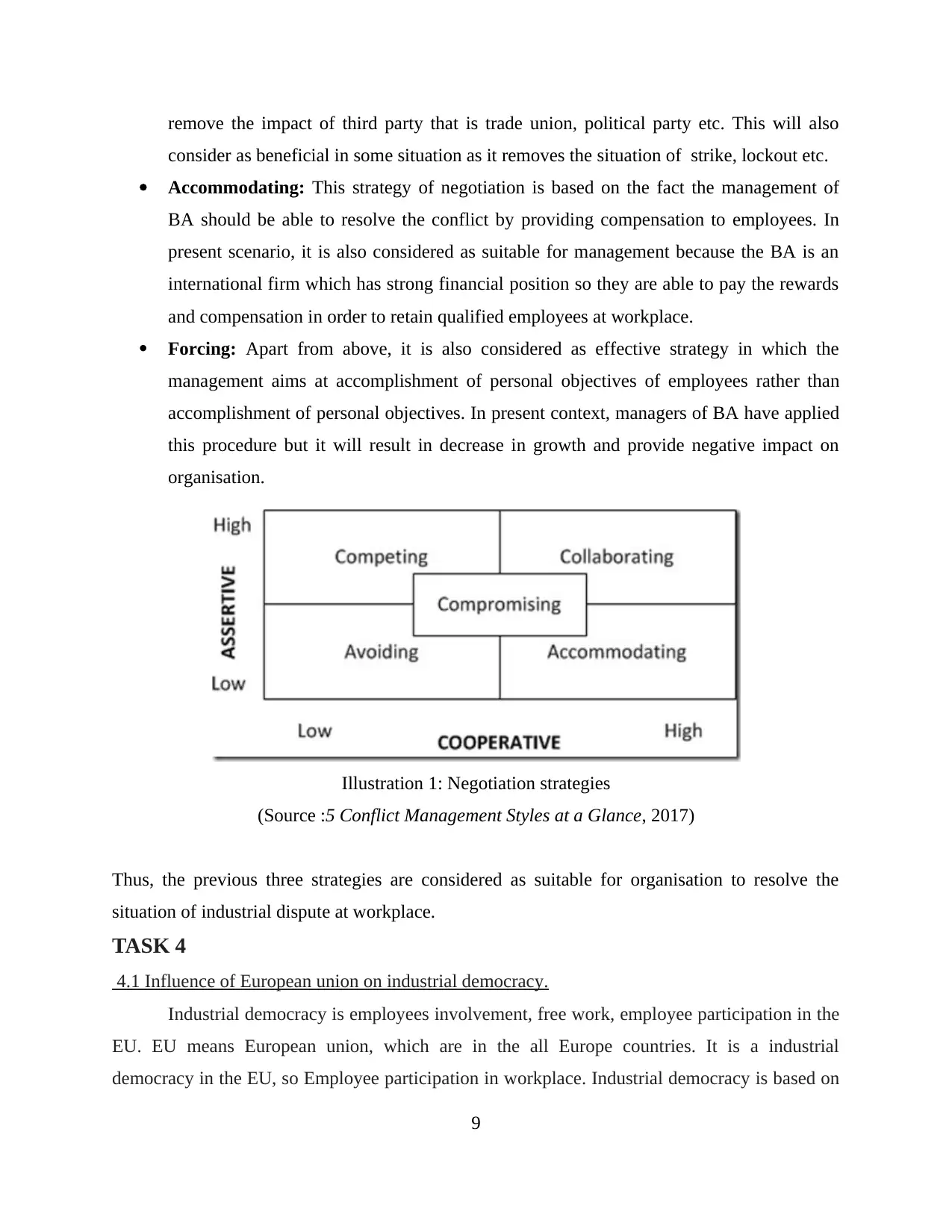
remove the impact of third party that is trade union, political party etc. This will also
consider as beneficial in some situation as it removes the situation of strike, lockout etc.
Accommodating: This strategy of negotiation is based on the fact the management of
BA should be able to resolve the conflict by providing compensation to employees. In
present scenario, it is also considered as suitable for management because the BA is an
international firm which has strong financial position so they are able to pay the rewards
and compensation in order to retain qualified employees at workplace.
Forcing: Apart from above, it is also considered as effective strategy in which the
management aims at accomplishment of personal objectives of employees rather than
accomplishment of personal objectives. In present context, managers of BA have applied
this procedure but it will result in decrease in growth and provide negative impact on
organisation.
Thus, the previous three strategies are considered as suitable for organisation to resolve the
situation of industrial dispute at workplace.
TASK 4
4.1 Influence of European union on industrial democracy.
Industrial democracy is employees involvement, free work, employee participation in the
EU. EU means European union, which are in the all Europe countries. It is a industrial
democracy in the EU, so Employee participation in workplace. Industrial democracy is based on
9
Illustration 1: Negotiation strategies
(Source :5 Conflict Management Styles at a Glance, 2017)
consider as beneficial in some situation as it removes the situation of strike, lockout etc.
Accommodating: This strategy of negotiation is based on the fact the management of
BA should be able to resolve the conflict by providing compensation to employees. In
present scenario, it is also considered as suitable for management because the BA is an
international firm which has strong financial position so they are able to pay the rewards
and compensation in order to retain qualified employees at workplace.
Forcing: Apart from above, it is also considered as effective strategy in which the
management aims at accomplishment of personal objectives of employees rather than
accomplishment of personal objectives. In present context, managers of BA have applied
this procedure but it will result in decrease in growth and provide negative impact on
organisation.
Thus, the previous three strategies are considered as suitable for organisation to resolve the
situation of industrial dispute at workplace.
TASK 4
4.1 Influence of European union on industrial democracy.
Industrial democracy is employees involvement, free work, employee participation in the
EU. EU means European union, which are in the all Europe countries. It is a industrial
democracy in the EU, so Employee participation in workplace. Industrial democracy is based on
9
Illustration 1: Negotiation strategies
(Source :5 Conflict Management Styles at a Glance, 2017)
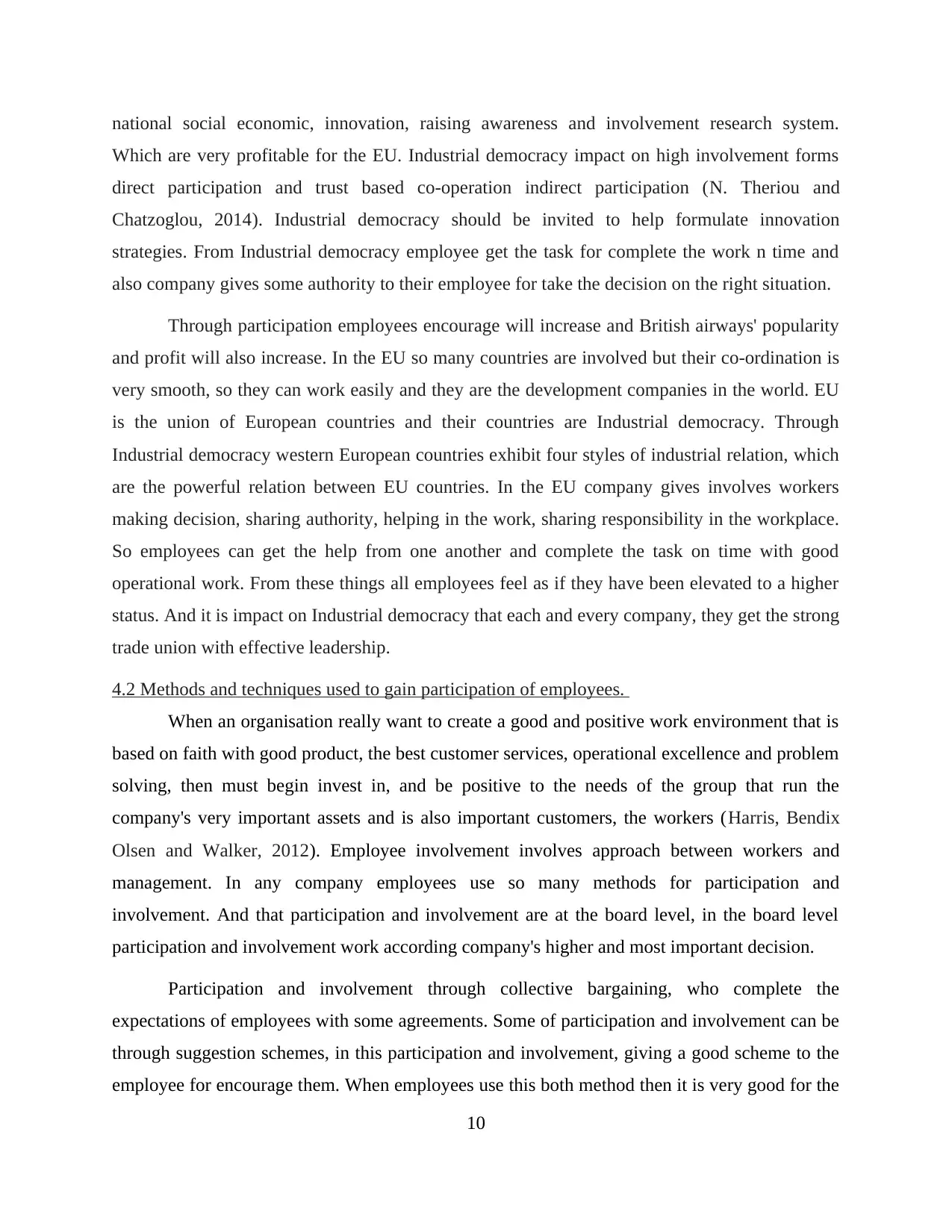
national social economic, innovation, raising awareness and involvement research system.
Which are very profitable for the EU. Industrial democracy impact on high involvement forms
direct participation and trust based co-operation indirect participation (N. Theriou and
Chatzoglou, 2014). Industrial democracy should be invited to help formulate innovation
strategies. From Industrial democracy employee get the task for complete the work n time and
also company gives some authority to their employee for take the decision on the right situation.
Through participation employees encourage will increase and British airways' popularity
and profit will also increase. In the EU so many countries are involved but their co-ordination is
very smooth, so they can work easily and they are the development companies in the world. EU
is the union of European countries and their countries are Industrial democracy. Through
Industrial democracy western European countries exhibit four styles of industrial relation, which
are the powerful relation between EU countries. In the EU company gives involves workers
making decision, sharing authority, helping in the work, sharing responsibility in the workplace.
So employees can get the help from one another and complete the task on time with good
operational work. From these things all employees feel as if they have been elevated to a higher
status. And it is impact on Industrial democracy that each and every company, they get the strong
trade union with effective leadership.
4.2 Methods and techniques used to gain participation of employees.
When an organisation really want to create a good and positive work environment that is
based on faith with good product, the best customer services, operational excellence and problem
solving, then must begin invest in, and be positive to the needs of the group that run the
company's very important assets and is also important customers, the workers (Harris, Bendix
Olsen and Walker, 2012). Employee involvement involves approach between workers and
management. In any company employees use so many methods for participation and
involvement. And that participation and involvement are at the board level, in the board level
participation and involvement work according company's higher and most important decision.
Participation and involvement through collective bargaining, who complete the
expectations of employees with some agreements. Some of participation and involvement can be
through suggestion schemes, in this participation and involvement, giving a good scheme to the
employee for encourage them. When employees use this both method then it is very good for the
10
Which are very profitable for the EU. Industrial democracy impact on high involvement forms
direct participation and trust based co-operation indirect participation (N. Theriou and
Chatzoglou, 2014). Industrial democracy should be invited to help formulate innovation
strategies. From Industrial democracy employee get the task for complete the work n time and
also company gives some authority to their employee for take the decision on the right situation.
Through participation employees encourage will increase and British airways' popularity
and profit will also increase. In the EU so many countries are involved but their co-ordination is
very smooth, so they can work easily and they are the development companies in the world. EU
is the union of European countries and their countries are Industrial democracy. Through
Industrial democracy western European countries exhibit four styles of industrial relation, which
are the powerful relation between EU countries. In the EU company gives involves workers
making decision, sharing authority, helping in the work, sharing responsibility in the workplace.
So employees can get the help from one another and complete the task on time with good
operational work. From these things all employees feel as if they have been elevated to a higher
status. And it is impact on Industrial democracy that each and every company, they get the strong
trade union with effective leadership.
4.2 Methods and techniques used to gain participation of employees.
When an organisation really want to create a good and positive work environment that is
based on faith with good product, the best customer services, operational excellence and problem
solving, then must begin invest in, and be positive to the needs of the group that run the
company's very important assets and is also important customers, the workers (Harris, Bendix
Olsen and Walker, 2012). Employee involvement involves approach between workers and
management. In any company employees use so many methods for participation and
involvement. And that participation and involvement are at the board level, in the board level
participation and involvement work according company's higher and most important decision.
Participation and involvement through collective bargaining, who complete the
expectations of employees with some agreements. Some of participation and involvement can be
through suggestion schemes, in this participation and involvement, giving a good scheme to the
employee for encourage them. When employees use this both method then it is very good for the
10
⊘ This is a preview!⊘
Do you want full access?
Subscribe today to unlock all pages.

Trusted by 1+ million students worldwide
1 out of 17
Related Documents
Your All-in-One AI-Powered Toolkit for Academic Success.
+13062052269
info@desklib.com
Available 24*7 on WhatsApp / Email
![[object Object]](/_next/static/media/star-bottom.7253800d.svg)
Unlock your academic potential
Copyright © 2020–2025 A2Z Services. All Rights Reserved. Developed and managed by ZUCOL.





